The iPhone 7 and iPhone 7 Plus Review: Iterating on a Flagship
by Joshua Ho & Brandon Chester on October 10, 2016 8:00 AM EST- Posted in
- Smartphones
- Apple
- Mobile
- iOS
- iOS 10
- iPhone 7
- iPhone 7 Plus
Battery Life
As-is, one of the most important factors for upgrading a smartphone remains battery life, due to a combination of inherent demand for a phone that can last 2-3 days of use and applications that demand enormous amounts of performance over long periods of time. Apps like WeChat are fairly notorious for holding wakelocks on Android and never really stopping background resource usage so there’s also an element of OS optimization that goes with keeping real-world in battery life up to expectations.
In order to test these things, we’ve spent the past year developing and validating a new web browsing battery life test which updates the sites used and introduces a scrolling component which attempts to better model how a number of tasks are not simply race to sleep and contain a steady-state component. We’ve also updated our rundown tests to better reflect reality and maintain appropriate loads as some devices with high-end SoCs and low display resolution were outpacing our testing. As always, all displays are set to 200 nits with location and other background services disabled to reach a useful relative comparison.

Looking at our WiFi web browsing test, it’s genuinely ridiculous how well the iPhone 7 and 7 Plus perform in this test. The iPhone 7 Plus is definitely down on battery life compared to the Galaxy S7 Edge, but it’s within 5% despite using a battery that’s almost 20% smaller. The iPhone 7 is actually comparable in battery life to the iPhone 7 Plus, and is significantly above the Galaxy S7 with Exynos 8890. Of course, the iPhone 7 has a significantly lower resolution display and a smaller battery, but the nature of smartphone design is that larger devices will generally have better battery life because the board area needed remains mostly constant while the amount of area for battery increases. The iPhone 7 has significantly improved in battery life here, likely due to a combination of A10 Fusion's power optimizations – particularly the small CPU cores – and the removal of the headphone jack, which teardown photos show to have been partially replaced with the battery. However if you do the math efficiency sees a relatively minor uplift.
One other interesting point is that Brandon accidentally ran the battery test on his iPhone 7 with a Safari Content Blocker enabled, which blocked all the ads on the sites that the test visits. In doing so, battery life rose from the normal result of 9.22 hours to 10.03 hours, demonstrating how the increased workload and long-running network requests from ads and trackers really impacts a smartphone's battery life. It's also worth noting that our test constantly cycles through pages, so if you spend a lot of time on a single page with ads you could see an even greater difference.
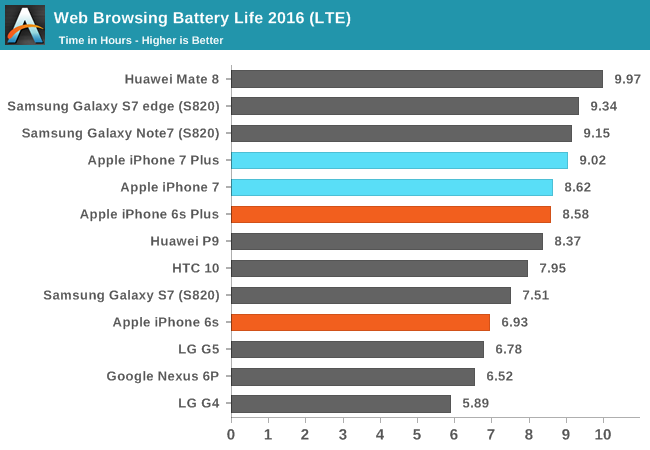
Moving on to LTE battery life the iPhone 7 and 7 Plus both slip a bit, but remain impressive. I suspect that the 20nm Qualcomm modem here is not well-equipped to handle the endless stream of ads that is increasingly a part of most websites. As ads tend to stream in incredibly slowly, the standby power of the modem is a significant factor. Snapdragon 820 devices don’t see nearly the impact here that the iPhone 7 and 7 Plus as their modem is on 14LPP rather than 20SoC. The iPhone 7 remains above the S820 Galaxy S7, but the iPhone 7 Plus is fairly comparable to the iPhone 6s Plus in battery life on LTE.

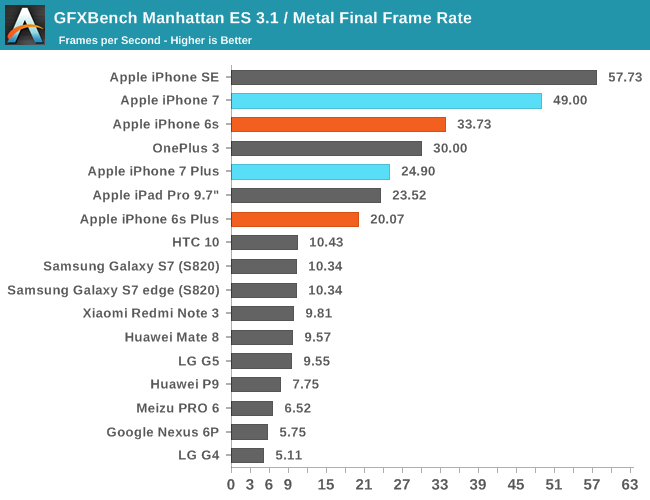
Moving past the web browsing test we use we can take a look at how the iPhone 7 Plus throttles. Unfortunately Basemark OS II was basically broken in this regard for the CPU rundown test so we can only look at how it behaves on Manhattan 3.1, but it's interesting to see how the GPU performance drops about 40% for the iPhone 7 Plus while the iPhone 7 throttles around 20%, because even Manhattan 3.1 is pegged to vsync which means that the GPU can spend much more time idling once a given frame is rendered. It's probably not a surprise here but the iPhone 7 just doesn't last very long here because battery life is strongly SoC-bound. If you attempted to plot battery life as a function of overall SoC utilization, it's entirely possible that the iPhone 7 might last longer than the 7 Plus at the lower bound for utilization, but as soon as you go past web browsing and similarly "light" tasks the 7 Plus and most phablets are going to strongly outperform such a small phone. Here the larger battery helps to get the iPhone 7 Plus nearly another hour of battery life when the SoC is under full, continuous load.
Charge Time
As usual, while battery life is the salient characteristic that determines overall mobility, it’s important to not ignore charge time as there are a number of edge cases where charging has a significant impact on overall mobility. In order to test this we use power measurements at the wall and measure the time it takes from the moment that the charger is plugged in to the moment that it falls below a pre-determined draw from the wall. While this isn’t perfect due to varying levels of DC conversion efficiency and different methods of trickle charging, this method provides at least a reasonable approximation of how long it will take to charge a device.
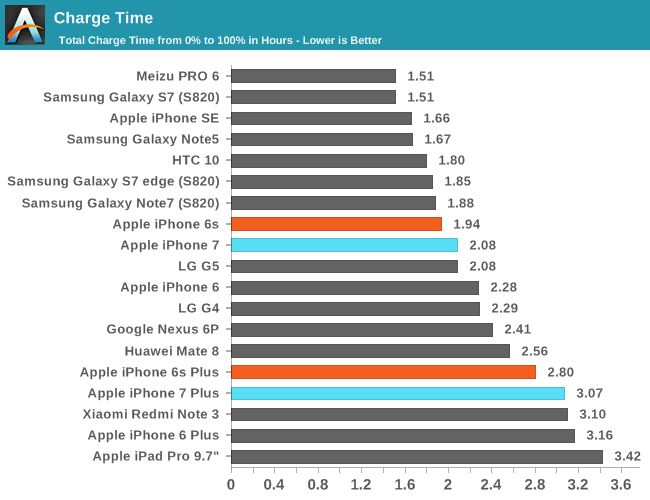
In the case of the iPhone 7 and 7 Plus, Apple continues to ship their standard 5W chargers for US variants. Looking at the results, it’s probably obvious that at least in the case of the iPhone 7 Plus, there is a very real need for Apple to start shipping something with faster charging, as the standard 5W charger takes a full hour longer than most of its competition to charge to 100%. Even the iPhone 7 could use a higher power charger here as using the device while it is charging will significantly impact the charging rate as the charger cannot supply enough power to the board while also charging the battery. And in the case of both phones, the lack of a high power charger doesn't just draw out the total charge time, but it also precludes rapid charging (partially charging a depleted phone very quickly) as well.
It would really be prudent for Apple to start to transitioning to higher power AC adapters at this point. This doesn’t take away from how impressive battery life is, but overall mobility isn’t going to be better than the competition unless you go out of your way to buy an iPad charger.


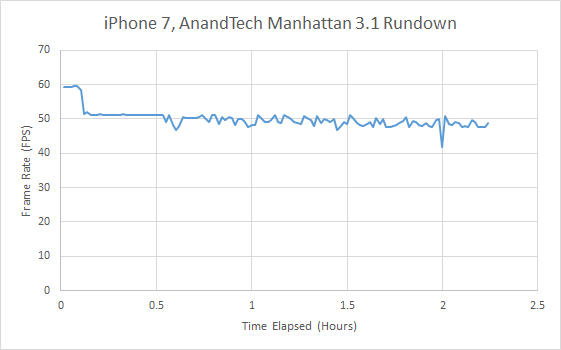
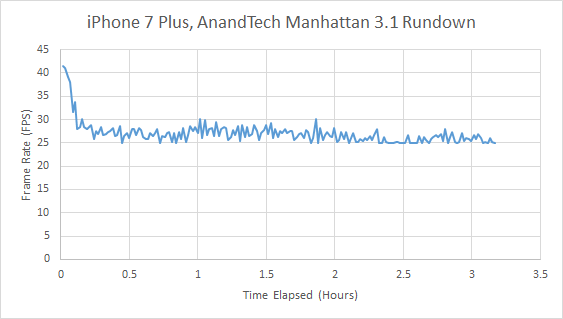
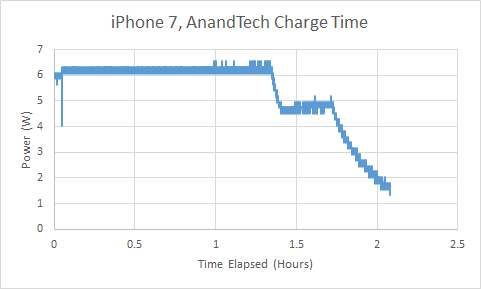
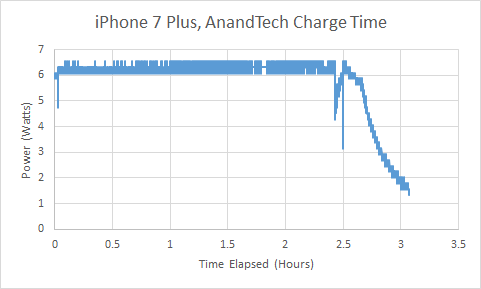








377 Comments
View All Comments
grayson_carr - Monday, October 10, 2016 - link
You can still use your old headphones with the adapter included in the box.The Pixel has a better camera? I didn't realize reviews were already out.
Mediocre battery life? Did you even read the review? the only noteworthy phone that beats the iPhone 7 is the S7 Edge, and it beats it by what, 20 minutes?
The iPhones will charge a lot faster if you buy an iPad charger. Sucks that they don't include a higher W charger in the box, but you at least have an option for faster charging.
Good to know the screen with the most accurate colors of any phone ever, and the only one to include proper color management, and one of brightest screens of all time is passable!
So it's not worth $650-750 for you. Ok. That's fine. It seems to be worth that much to a whole bunch of other people though.
SquarePeg - Monday, October 10, 2016 - link
https://www.dxomark.com/Mobiles/Pixel-smartphone-c...grayson_carr - Tuesday, October 11, 2016 - link
Well if they said it, it must be true. After some of the scores they have given certain Sony phones, I will never trust them.jlabelle2 - Thursday, October 13, 2016 - link
"After some of the scores they have given certain Sony phones, I will never trust them."Here we are again... And earth is flat, I know...
mef - Monday, October 10, 2016 - link
"The screen is just passable": really???http://www.displaymate.com/iPhone7_ShootOut_1.htm
The iPhone 7 matches or breaks new Smartphone display performance records for:
• The Highest Absolute Color Accuracy for any display (1.1 JNCD) – Visually Indistinguishable from Perfect
• The Highest Absolute Luminance Accuracy for any display (±2%) – Visually Indistinguishable from Perfect
• Very Accurate Image Contrast and Intensity Scale (with Gamma 2.21) – Visually Indistinguishable from Perfect
• The Highest Peak Brightness Smartphone for any Average Picture Level APL (602 to 705 nits)
• The Highest (True) Contrast Ratio for any IPS LCD display (1,762) – Higher Dynamic Contrast Ratios are phony
• The Lowest Screen Reflectance for any Smartphone display (4.4 percent)
• The Highest Contrast Rating in High Ambient Light for a Smartphone for any APL (137 to 160)
• The Smallest Color variation with Viewing Angle (2.1 JNCD or less)
Toss3 - Tuesday, October 11, 2016 - link
They compared it to the iPhone 6, and while it is accurate, many people would still pick an AMOLED screen over the LCD any day of the week; samsung's recent amoled-screens are almost as accurate (negligible difference really, with infinite contrast and higher perceived sharpness both due to an increase in contrast and pixel density).R. Hunt - Thursday, October 13, 2016 - link
OLED will only be accepted by mainstream media as vastly superior the moment Apple starts using it.We all know this.
techconc - Thursday, October 13, 2016 - link
No, DisplayMate's review was not simply comparing the screen to the iPhone 6. There are areas where the iPhone 7 screen is best in class overall. Moreover, in a recent Wired article Dr. Soneira went on to say that the best screen overall is a "toss up" between the Galaxy's OLED and the iPhone 7's LCD. Both have inherent strengths and weaknesses. Neither is better overall.https://www.wired.com/2016/09/iphone-7s-screen-loo...
Constructor - Monday, October 17, 2016 - link
No, they're not, since Android has no color management whatsoever. Plus AMOLED deteriorates over time, including pixel-wise burn-in and incremental color degradation (also varying across the display area).Samsung et al clearly don't care much about as you can see from their short support span for these devices, but Apple devices are often used for many years and they stay very high quality for years; They also get full update and upgrade support directly from Apple for 5 years.
AMOLED is simply not good enough and not durable enough for that, even if you did calibrate it in the factory and if you had an OS with color management.
TechnologyGuy - Monday, October 10, 2016 - link
I specifically made no mention of the OS because that is subjective. I have owned both Android and iOS phones and I have always preferred Android over iOS. I do understand people might prefer one over the other but I like to micro-manage and customization of every little detail is important to me.Yes, Pixel camera reviews are out - please search for yourself. Plugging in an adapter/dongle is not what I want to bother to do every time I use the phone. An extra accessory to lose, a feature that adds zero (negative) value for me. Battery life in real world usage is not quite the same as on the test - two of my colleagues have already acquired the phone with poorer battery life than the 6S. In addition, other sites' battery tests do show mediocre results for the iPhone 7.
I am aware of the color accuracy, which is why I said passable. Simply put, a so-so black level and a resolution below quad HD is not acceptable for my use. And yes, I can tell the difference on a 5 inch phone.